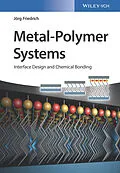The result of decades of research by a pioneer in the field, this is the first book to deal exclusively with achieving high-performance metal-polymer composites by chemical bonding. Covering both the academic and practical aspects, the author focuses on the chemistry of interfaces between metals and polymers with a particular emphasis on the chemical bonding between the different materials. He elucidates the various approaches to obtaining a stable interface, including, but not limited to, thermodynamically driven redox reactions, bond protection to prevent hydrolysis, the introduction of barrier layers, and stabilization by spacer molecules. Throughout, chemical bonding is promoted as a simple and economically viable alternative to adhesion based on reversible weak physical interaction. Consequently, the text equips readers with the practical tools necessary for designing high-strength metal-polymer composites with such desired properties as resilience, flexibility, rigidity or degradation resistance.
Autorentext
Jorg Friedrich was the Department Head of Polymer Surfaces at the Federal Institute of Materials Research and Testing (BAM) in Berlin, Germany. He has obtained his academic degrees from Humboldt University Berlin, Academy of Sciences Berlin (AdW) and the Technical University of Berlin. He spent most of his career working for AdW before taking up his present appointment at BAM. Professor Friedrich has authored more than 300 scientific publications and has received numerous scientific awards. He is member of the editorial boards of four international journals.
Inhalt
Preface xi
1 High-Performance MetalPolymer Composites: Chemical Bonding, Adhesion, and Interface Design 1
1.1 Introduction 1
References 10
2 Interpretation of Adhesion Phenomena Review of Theories 13
2.1 General 13
2.2 Mechanical Interlocking 20
2.2.1 Mechanical Interlocking in a Macroscopic Scale 20
2.2.2 Mechanical Adhesion on a Microscale 20
2.2.3 Mechanical Anchoring on a Molecular Scale 21
2.3 Interdiffusion 23
2.3.1 Diblock Copolymers for Interface-Crossing Adhesion Promotion 23
2.3.2 Interdiffusion andWelding 23
2.3.3 Diffusion of Metals into Polymers 25
2.4 Interphase Formation 28
2.4.1 PolymerPolymer Blends 28
2.4.2 Nanoparticle Composites 29
2.4.3 Transcrystalline Layers 29
2.4.4 Redox Reactions across the MetalPolymer Interface 30
2.4.5 Reactions of Transition Metals with Aromatic Polymers 32
2.4.6 Loss in Anisotropic Orientation of Polymers Caused by Pretreatment or by Contact to Metals 34
2.4.7 Weak Boundary Layer 36
2.5 Weak Molecular Interactions (Cohesive Forces) 38
2.5.1 Thermodynamic Adsorption,WettingModel 38
2.5.2 Contact Angle, Surface Properties, and Adhesion 39
2.5.3 Contact Angle Measurement 40
2.5.4 Advancing and Receding Contact Angles, Contact Angle Hysteresis 42
2.5.5 Real Surfaces 43
2.5.6 Critical Surface Tension Zisman Plot 44
2.5.7 Surface TensionTheories 46
2.5.8 Polar and Dispersive Components of Surface Tension 47
2.5.9 AcidBase Interactions 48
2.5.10 Rheological Model 51
2.5.11 Summary 51
2.6 Electrostatic Attraction 52
2.7 Contaminations, Role ofWater, or Humidity 54
2.8 Coupling Agents 55
2.9 Use of Glues (Adhesives) 59
2.10 Hydrophobic Recovery 70
References 72
3 Interactions at Interface 89
3.1 Composites and Laminates 89
3.2 Laminate Processing 90
3.3 Polymers as Substrate or as Coating 92
3.4 Chemical Reactions at Surfaces 92
3.4.1 Chemisorption 92
3.5 Reactions of Metal Atoms with Polyolefins 97
3.6 Reaction of Metal Atoms with O-Functional Groups at Polymer Surfaces 97
3.7 Reactions of Metal Atoms with Amino Groups on Polymer Surfaces 105
3.8 Silane and Siloxane Adhesion-Promoting Agents 105
References 107
4 Chemical Bonds 113
4.1 Bonds in Polymers 113
4.1.1 Covalent CH and CC Bonds in Polymers 113
4.1.2 CC Double, Triple, Conjugated, and Aromatic Bonds 116
4.1.3 CO, C=O, OC=O, and O=COO Bonds in Polymers 117
4.1.4 N-Containing Functional Groups 118
4.1.5 Chemical Bonds in Other Materials 119
4.2 Reactions of Chemical Bonds during Pretreatment 119
4.2.1 Aliphatic Chains 119
4.2.2 Preformed Degradation Products and Preferred Rearrangement Processes 121
4.3 Chemical Bonds at Interface 122
4.3.1 PolymerPolymer Linking 122
4.3.2 CarbonMetal Bonds 123
4.3.3 Covalent Bonds between Oxides and Polymers 126
4.3.4 Interface between Polymers and Transition Metals 127
References 130
5 Functional Groups at Polymer Surface and Their Reactions 135
5.1 OH Groups at Surface 135
5.2 Primary Amino Groups at Polymer Surfaces 140
5.3 Carboxylic Groups as Anchor Points for Grafted Molecules 143
5.4 Bromination 146
5.5 Silane Bonds 147
5.6 Click Chemistry 148
5.7 ATRP 150
5.8 Grafting 152
5.8.1 Grafting of Fluorescence Markers onto Functional Groups at Polyolefin Surfaces 153
5.8.2 Covalent Linking of Spacer Bonded Dye Sensors onto Polyolefin Surfaces 154
5.8.3 Covalent Linking of Spacer Bonded Dye Sensors onto Polyolefin Surfaces Supported by a Cucurbituril Jacket 155
5.8.4 Grafting of Polygl...
